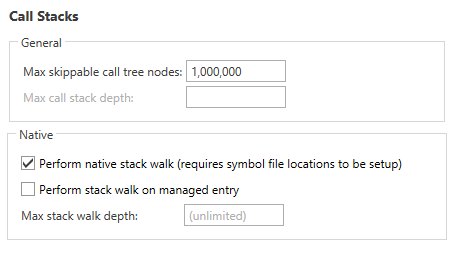Call Stacks Settings Page
The Call Stacks settings page is used to define how call stacks should be collected and reduced. The call stacks settings are divided into three pages: General, Managed, and Native (Professional and Enterprise only).

The following settings are available under the Call stacks page:
Max skippable call tree nodes
Defines the total number of stack call tree nodes that are allowed in for call stacks, before the call stack reducer tries to remove nodes.
Max call stack depth
Call stacks can no longer be limited to a maximum depth. This is something that may be re-implemented in a future version of .NET Memory Profiler, if deemed necessary.
Perform native stack walk
This option is used to select whether native stack walks should be performed. By enabling native stack walks, detailed information can be retrieved about native resource creation. However, the stack walks will slow down the profiled process and the profiler needs to have access to the symbol files of the native libraries in the call stack. The symbol file locations are defined using the Symbol File Locations preferences page.
Note
The first time a frame is encountered by the native stack walker, .NET Memory Profiler needs to retrieve information about the frame from the debug symbols. This can take some time, especially if the symbols need to be downloaded. However, the symbol information will be cached by .NET Memory Profiler, which will make subsequent stack walks very much faster.
Max stack walk depth
Defines how many frames the native stack walker should investigate during a stack walk (this includes both frames that will be included in the stack and frames that are skipped based on the Include native functions settings). To remove the stack walk depth limit, press Ctrl-0 (zero).
Perform stack walk on managed entry
Defines whether a native stack walk should be performed when a managed method is entered. Enabling this option will include additional call stack frames during native to manage transitions (i.e. native stack information will be presented between the [Managed to native transition] and [Native to managed transition] frames) and thread start methods (e.g. the Main method). The additional information provided by these frames is often not very important, so unless needed it is recommended that this option be disabled.